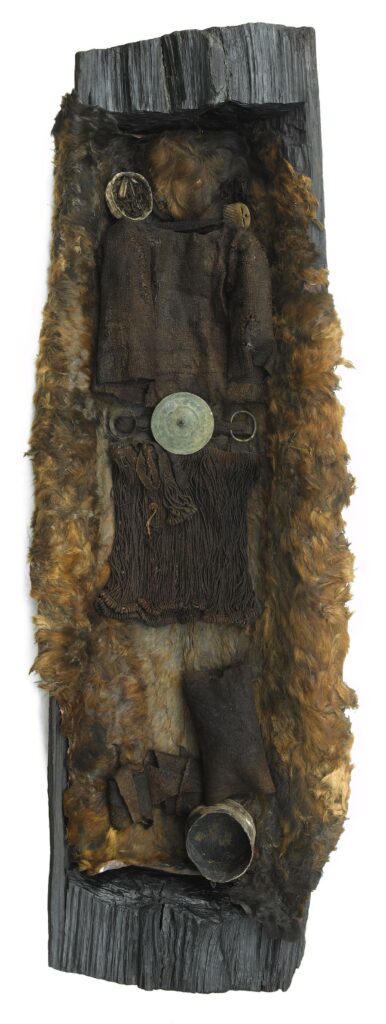
The grave of the Egtved Girl provides many clues for what life might have been life for girls in the Early Bronze Age.
Egtved Girl (13??-1370 B.C.E.) is the name given to the remains of a young woman found in Egtved, Denmark. The Egtved Girl lived in the Bronze Age (1700-500 B.C.E.), when people first built weapons and jewelry out of bronze instead of stone. Based off of the time of her death, the Egtved Girl lived in the Early Bronze Age. Our knowledge of life at that time stems from archeological findings. For example, in the Early Bronze Age, some people were laid to rest in burial mounds. Preserved burials, like Egtved Girl, give evidence to the past. From Egtved’s remains, researchers have discovered more information on trade at the time and the mobility of women and girls in this time.
The Bronze Age was a transformative time. In Scandinavia, people did not live in villages, but in dispersed settlements. Families lived in longhouses, which may have been multi-generational homes. Additionally, the sun was central to Bronze Age religion. Discovered objects, symbols, and illustrations help point archeologists and historians to these facts. Notably, trade connected people in this time. Throughout the Bronze Age, people traded goods from Nordic Europe, Central Europe, the Mediterranean, Mesopotamia, and North Africa. The Egtved Girl helps prove that girls in the Bronze Age were also mobile. Archeologists first inspected Egtved’s remains in 1921. Yet, as technology develops, researchers discover more about her life. Scientific dating shows that throughout the last few months of her life she travelled to different locations. Some researchers even believe that she may have travelled from Germany to Denmark.
The objects buried with the Egtved Girl provides clues about her life. Often, these objects provide more questions than answers. In her grave, The Egtved Girl wore a corded skirt. The skirt is the only fully preserved corded skirt discovered from the Early Bronze Age. Shocking archeologists in the 1920s, the Egtved Girl appeared to wear the skirt above the knee. Because her outfit challenged their norm, these archeologists thought she held a special role in society as a “ritual dancer.” Symbols of dancing from the Early Bronze Age lead historians to believe that girls participated in ritual dancing. While the Egtved Girl might have been a ritual dancer, this is only an assumption. This view may be an interpretation attempting to make sense of archeological findings that disrupt modern norms. With only limited information, we do not know the specific role Egtved held in her family or society.
Moreover, jewelry, a flower, personal items, and other objects were in the grave. These objects provide more information on trade, wealth, and life in the Early Bronze Age. Yet another cause for debate is the remains of a small child found in the grave. The estimated age for the Egtved Girl is 16-18, with the younger child’s age estimated between 5-6. Research on the younger child’s relation to the Egtved Girl is inconclusive. The National Museum of Denmark proposes that the younger child may be a human sacrifice. However, in communications with Flemming Kaul, curator and senior researcher at the National Museum, he suggests reconsidering this view. The younger child might have been the Egtved Girl’s daughter, sister, other family member, or otherwise connected to the Egtved Girl. The Egtved Girl and the younger child may have died around the same time. Or, the younger child was not buried until the death of the Egtved Girl. The younger child might have needed a “proper adult” to lead her in death. By many modern standards, Egtved Girl was a girl. Yet, most likely, she was a woman in Early Bronze Age society, and a person who could guide others.
Egtved Girl’s remains are in the National Museum of Denmark, and she is a symbol of Danish history. A rebuilt burial mound is accessible to the public in Egtved. The Egtved Girl offers new research for the life of girls and women in the Early Bronze Age. She challenges assumptions and offers new questions.
For more information on the Bronze Age in Denmark, read Organizing Bronze Age Societies: The Mediterranean, Central Europe, and Scandinavia, edited by Timothy Earle and Kristian Kristiansen (New York: Cambridge University Press, 2010).
For more information on The Egtved Girl, read The Egtved Girl: Travel, Trade & Alliances in the Bronze Age, by Louise Felding.
